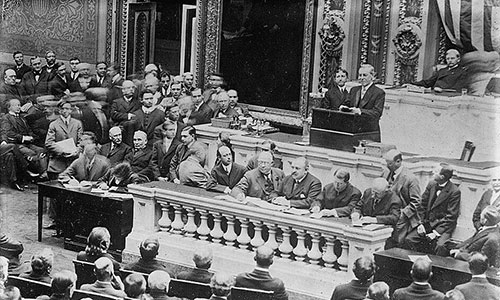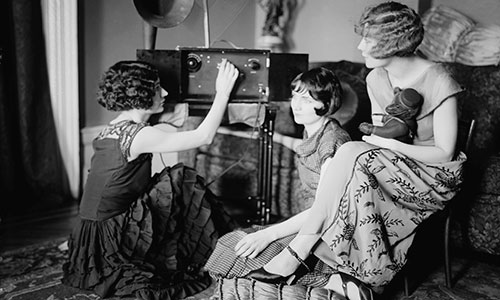State of the #SOTU
The State of the Union address wasn't always a big deal. You can credit (or blame) Woodrow Wilson and evolving technology for changing that.

Blame Woodrow Wilson
For the first 150ish years of our country, the State of the Union was not the event it is now. George Washington did yearly big speeches during his first term, but Thomas Jefferson ended the practice when he took office, sending along a written report instead. He handed off his message to Congress, and a clerk read it in his place. (Imagine watching something like that on C-SPAN—as well as the tweets it might inspire.)
That’s generally what most presidents did until Woodrow Wilson decided that he wanted to make a huge freaking deal about it in 1913.
“I shall ask your indulgence if I venture to depart in some degree from the usual custom of setting before you in formal review the many matters which have engaged the attention and called for the action of the several departments of the Government or which look to them for early treatment in the future, because the list is long, very long, and would suffer in the abbreviation to which I should have to subject it,” Wilson said during that first address in a very, very, long sentence.
Wilson’s change to tradition was so effective that it actually became a tradition of its own—one so ingrained that we don’t even realize it hasn’t been happening the whole time.
1981
The last year the State of the Union Address was given as a written address, rather than an oratorical one. The address, given by Jimmy Carter in the waning days of his presidency, came as his popularity was in tatters due to the Iran hostage crisis, something he references near the top of his 33,667-word address.
1989
The first year an unofficial State of the Union address was given. Ending a tradition of a departing president offering a written address at the end of his term, George H.W. Bush started his presidency with an address in February. Such a speech is not required by the the U.S. Constitution—as it, by its very nature focuses on what’s ahead, rather than what already happened—but every president since has given an unofficial SOTU address in their first few weeks in office.

How tech defined the SOTU
Wilson was only partly responsible for the SOTU's shift in prominence. Slowly, new technology began to require changes to the format—because, now, people could listen live.
Calvin Coolidge was the first to have his State of the Union address on radio in 1923—a tinny address in which listeners could hear Coolidge turn each page. (“Mr. Coolidge was known as a quiet man, but he was the first president to use the medium of radio to his advantage,” The New York Times wrote in 2011.)
In 1936, however, Franklin Delano Roosevelt made one significant change that made the speech significantly more impactful: starting that year, he started presenting the addresses at night, a move that turned a perfunctory part of the president’s job into an event.
FDR, ever the media-savvy politician, began to treat these speeches like things worthy of every American’s notice. At a time when more than 40 percent of Americans owned a radio, FDR had taken something modest and turned it into something epic. By 1940, 83 percent of Americans would own a radio, basically ensuring that the mass-media reach of the State of the Union meant that it was just as much for people at home as it was for the people in Washington.
(It’s worth noting, by the way, that FDR’s New Deal programs brought electricity to many rural parts of the country—a phenomenon that helped radio’s uptake.)
From there, things only got crazier: In 1947, Harry Truman brought the speech to television, and in 1965, Lyndon Johnson made it a prime-time affair. The rise of CNN (and later, Fox News) turned the SOTU into a political sport. Bill Clinton started livestreaming it online in 1997. Barack Obama mixed his live speeches with detailed infographics.
And, eventually, people found Twitter, and now, to put it in the nicest terms possible, it’s a total shitshow. Nonetheless, it's still be fun to watch.
Five defining SOTU moments
- Perhaps the greatest individual moment in State of the Union history came in 1941, when FDR introduced his “Four Freedoms”—freedom of speech, freedom to worship, freedom from want, and freedom from fear. Coming as it did as a World War was breaking out, the impact of the speech was massive. Here’s a PDF featuring some of the early drafts of this section of the speech.
- In 1974’s State of the Union address, Richard Nixon told the audience—both in Congress and at home—that “one year of Watergate is enough.” But it wasn’t enough, and eight months later, Nixon would resign.
- The next year, Nixon’s replacement, Gerald R. Ford, offered up a fairly humanizing line near the beginning of his speech: “I must say to you that the state of the Union is not good.” It was a riff on a line by Harry Truman in his 1949 speech, but the dramatic flip gave it a much more lasting impact.
- George W. Bush, just a few months after the September 11th attacks changed everything, used the term “Axis of Evil” to refer to North Korea, Iraq, and Iran—three countries that, as far as we know, had nothing to do with the 9/11 attacks. Here’s David Frum, the speechwriter who coined the phrase in 2002, defending his work.
- And just for kicks, the 1985 Democratic response to the State of the Union, which is ‘80s-tastic and gave America its first up-close look at Bill Clinton. (Most SOTU responses are awful, but at least this one had a Genesis soundtrack.) Clinton had a great one-liner of his own in 1996, when he announced that “the era of big government is over.” It wasn’t, but good effort.
1966
The first year that opposition parties gave televised responses to the State of the Union address. With Johnson giving his speeches at night all of a sudden, opposing parties needed to get their points of view in.
three
The number of State of the Union response-givers that eventually themselves became president—Gerald Ford (1966, the first year), George H.W. Bush (1967), and Bill Clinton (1985). A lot of wannabe presidential candidates have tried to do the same—some of whom got thirsty during the speech.
The State of the Union is a long speech, and it covers so many things that we forget most of the details about it within a week, if not within a day. But it's a great tradition, and one that’s perfect for drinking games, making fun of the weird relationship between Joe Biden and John Boehner, and tweeting random jokes that will be quickly forgotten about or turned into Twitchy posts that will be forgotten about even quicker.
As the half-lives on our news cycles decay ever so quickly, will the speech’s impact fade away over time? We'll leave that question to history. For now, bottoms up.
:format(jpeg)/2018/11/pnfvj81zlmkby9fvwlea--1-.gif)
/2018/11/pnfvj81zlmkby9fvwlea--1-.gif)

/uploads/ernie_crop.jpg)